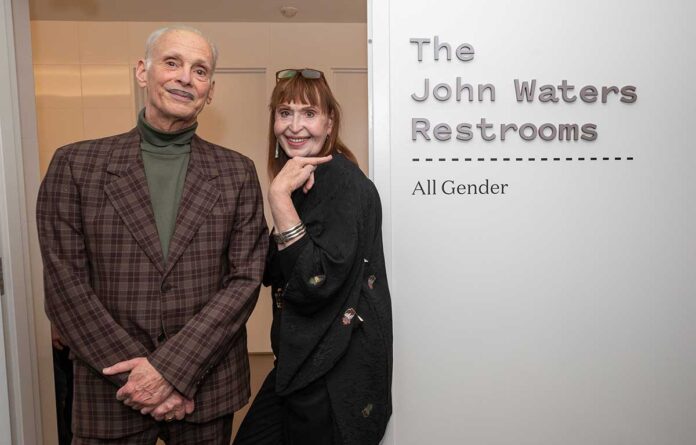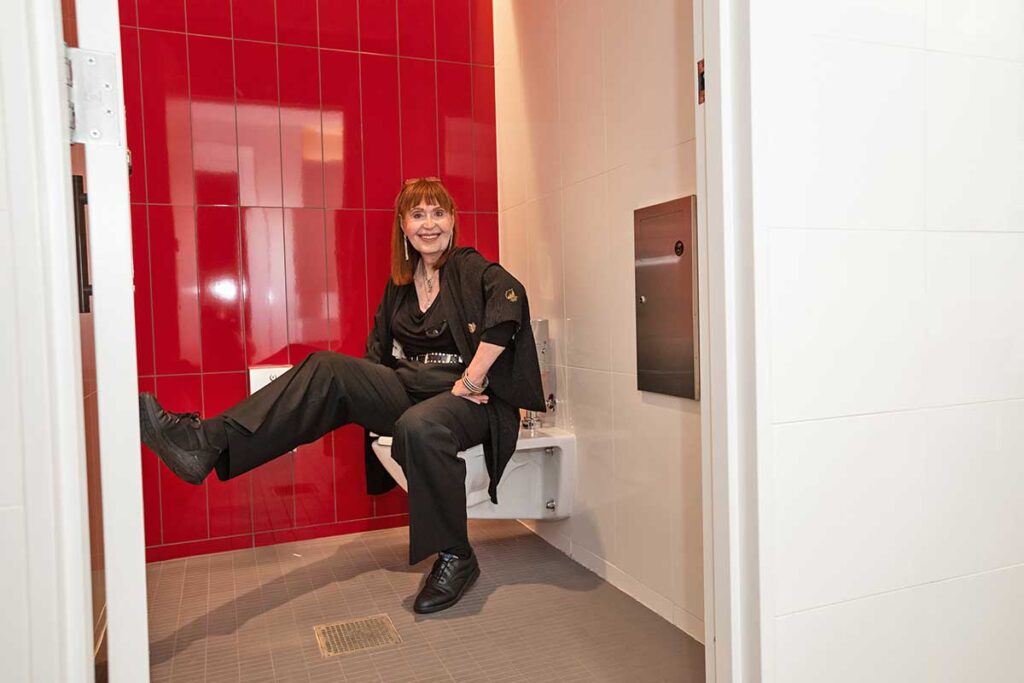
Local LGBTQ advocate Elizabeth Coffey Williams famously worked with John Waters, playing a flasher in his classic film, “Pink Flamingos” back in the 1970s. She also appeared in other Waters films, including “Female Trouble,” and “Hairspray.”
She reunited with the filmmaker last month at a private function, where she got to be the first person to use the new John Waters All-Gender Restroom at the Baltimore Museum of Art. (The bathrooms will open to the public on December 12).
In a recent phone interview, Williams spoke about the historic moment and the importance of safe spaces and advocacy.
I’m curious how you were selected to christen the John Waters Restrooms. What can you say about having this honor bestowed upon you?
My quick answer, is “Who else would he ask?!” [Laughs.] When they asked me, it was obvious; I was a logical choice. I don’t say that in a way that is self-serving, but all that time ago — and John has mentioned this, too — we didn’t have the word “transgender.” I was thrilled to go and do this because I was going to have some fun with John. The slant of the entire event harkens back to what John does: he makes a joke, but the subtext is frequently serious. So, when it comes to restrooms, people think, here he is again being the filthiest person alive. But the concept of gender inclusion — he made it rather clear that it mattered. It wasn’t “Ha Ha, name the toilets after me.” It was about gender inclusion. It might be a small thing, but it gets attention and if it makes a few people think, maybe that’s enough. He took the moment to do something that is admittedly playful, but playful with a purpose. In its own small way, it helped to be another statement about inclusivity and the importance of inclusivity.

Would it be impolite to ask if you were pee shy? I mean, surely there was pressure to perform here. Did you prepare for this historic event by drinking copious amounts of water?
No, I was at the event upstairs, and I had several glasses of sparkling water with lime, or a sprite, which is my cocktail of choice. Taking a piss isn’t like training for the Olympics. I didn’t poop, but I did make a toilet paper flower when I was in there. I said, “Look, John, I came out with a blossom.”
You have long been involved with transgender rights. Surely, this restroom is more suited to how things should be. What can you say about your efforts in the fight for all-gender bathrooms, and the difficulties of securing spaces where everyone can feel safe?
In the 70s in Baltimore, I used the girl’s bathroom. Do you know how awkward it would have been if I went in the men’s room? It would have caused more of a fuss. But it’s not about me. The bathroom issue is very important and something that is symbolic in so many ways. When relatively ordinary, decent, good people just want to live their life. And people make a huge issue out of them just going to the bathroom! I mean, to me that is just indicative of: If I can’t pee, I can’t have a shot of doing much else. The bathroom issue is symbolic of this systemic disdain that we have endured.
There are a lot of places that have bathrooms that are already designated correctly. It’s a complicated issue, because there are different kinds of privilege, and even all the way back then, when I was with John and I and my other loved ones in Baltimore who all became friends, I was aware I was carrying a certain kind of privilege because I did fly under the radar.
In addition to being a local community leader through your work with TransWay at the William Way Community Center, you are on the endorsement committee of Liberty City LGBT Democratic Club, and on the board of the Dr. Magnus Hirschfeld Fund. Can you talk about that activism?
I think I have to pop that balloon a little bit: I’m more an advocate than an activist. More times than not, when things present themselves that seem logical to me, I go where I’m able to do a little bit of good. I stress “a little bit” because there are so many people who do so much more than I do. Every single thing I do I take very seriously. I think if we as a community can stop quantifying and qualifying what other people might be doing, and just do our level best when we can, when we notice something that is an opportunity to make a little bit of a difference, even if it is a little bit, it behooves us to do it.
I lovingly and respectfully encourage people who are from subsequent generations to continue. I never considered myself a leader. When we look at TransWay, which is a great love of mine, I see doing that not as a great responsibility that I take very seriously because they entrusted me, but I see it as a great privilege to have some level of impact. William Way is the hub and the heartbeat of the community. So, whatever I can do, whether it is co-facilitate TransWay with a spectacular young woman named Kendall Stevens, I do. Before the pandemic, I was helping to lead tours on the building that helped familiarize people with the mission of William Way.
You live in the John C. Anderson Apartments, an LGBTQ-friendly senior living community. Like all-gender restrooms, this is an important safe space for the community
It sure is. I am also involved with SAGE, an advocacy group for LGBT seniors. I will do anything in the world for them. There is a responsibility to represent. I am blessed to be part of a community that for the most part embraces me. There is a value with the trans experience in just being visible. I’ve been standing up for so long, there is no point in sitting down. Whether you like it or not, we’re here. And we’ve always been here. The whole spectrum of LGBTQ+ has always been here.
We’ve talked about safe spaces, what can you say about the risky things you’ve done?
Darling, I am so desperately, shockingly pedestrian when you know the truth.
What about your appearance as the flasher in “Pink Flamingos”?It’s the second most notorious scene John filmed. It’s misunderstood because people think it’s lascivious. It was done at a time when folks who didn’t conform were the brunt of jokes. It was important to John that when we did the scene that I understood that I was the one making the joke not being the joke. That immediately appealed to me. That is the reason I “win” in the battle with David Lochary’s characters. People ask, “Why would you do that?” My first answer is, “It was really funny.” My second answer is, “I was really good at it.” John knew I was game, and that I had a good sense of humor and I would get it. If people don’t get it, I’m ok with that. I’m very unapologetic having done that even though some people think it’s lascivious. It worked.
